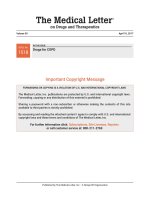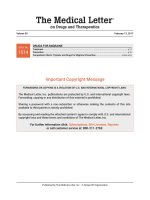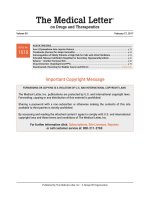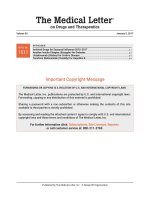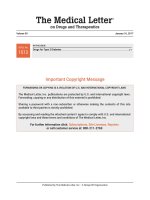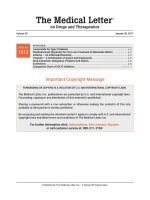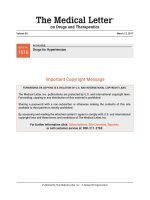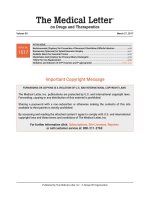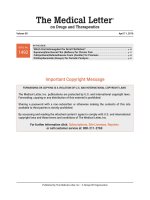The medical letter on drugs and therapeutics february 13 2017
Bạn đang xem bản rút gọn của tài liệu. Xem và tải ngay bản đầy đủ của tài liệu tại đây (190.37 KB, 9 trang )
The Medical Letter
®
on Drugs and Therapeutics
Volume 59
ISSUE
ISSUE
No.
1433
1514
Volume 56
February 13, 2017
DRUGS FOR MIGRAINE
Treatment ................................................................................................................................ p 27
Prevention ............................................................................................................................... p 30
Comparison Charts: Triptans and Drugs for Migraine Prevention ........................................online only
Important Copyright Message
FORWARDING OR COPYING IS A VIOLATION OF U.S. AND INTERNATIONAL COPYRIGHT LAWS
The Medical Letter, Inc. publications are protected by U.S. and international copyright laws.
Forwarding, copying or any distribution of this material is prohibited.
Sharing a password with a non-subscriber or otherwise making the contents of this site
available to third parties is strictly prohibited.
By accessing and reading the attached content I agree to comply with U.S. and international
copyright laws and these terms and conditions of The Medical Letter, Inc.
For further information click: Subscriptions, Site Licenses, Reprints
or call customer service at: 800-211-2769
Published by The Medical Letter, Inc. • A Nonprofit Organization
The Medical Letter publications are protected by US and international copyright laws.
Forwarding, copying or any other distribution of this material is strictly prohibited.
For further information call: 800-211-2769
The Medical Letter
®
on Drugs and Therapeutics
Volume 59
February 13, 2017
Take CME Exams
ISSUE
ISSUE No.
1433
1514
Volume 56
▶
DRUGS FOR MIGRAINE
Treatment ................................................................................................................................ p 27
Prevention ............................................................................................................................... p 30
Comparison Charts: Triptans and Drugs for Migraine Prevention ........................................online only
Treatment of Migraine
Recommendations for Treatment and Prevention of Migraine
Treatment
An oral nonopioid analgesic may be sufficient for
treatment of mild to moderate migraine without severe
nausea or vomiting. A triptan is the drug of choice for
treatment of moderate to severe migraine.1,2 Use of
a triptan early in an attack when pain is still mild to
moderate in intensity improves headache response
and reduces recurrence rates.
▶ A nonopioid analgesic may be effective for mild to moderate
ANALGESICS – Aspirin and acetaminophen, used
alone or together in combination with caffeine
(Excedrin Migraine, and others), and nonsteroidal
anti-inflammatory drugs (NSAIDs) such as naproxen
sodium (Aleve, and others) and ibuprofen (Advil,
Motrin, and generics) are effective in relieving mild to
moderate migraine pain.3-5 The NSAID diclofenac is
FDA-approved as a powder for oral solution (Cambia)
for treatment of migraine; it has a rapid onset of action
(about 15 minutes).6 Some patients may respond
better to one NSAID than to another.
▶
Products that combine butalbital and caffeine with
aspirin (Fiorinal, and others) or acetaminophen
(Fioricet, and others) are used for treatment of migraine
despite evidence that butalbital is not effective in relieving migraine pain. Their frequent use can lead to tolerance, addiction, and medication overuse headache.
Oral combinations of aspirin or acetaminophen with
an opioid can be effective for relief of migraine pain,
but they cause the usual opioid adverse effects (e.g.,
nausea, drowsiness, and constipation), and regular use
can lead to dependence and addiction.
Pregnancy – Occasional use of acetaminophen
for treatment of mild to moderate migraine during
pregnancy is generally considered safe.
TRIPTANS – The short-acting oral serotonin (5-HT1B/1D)
receptor agonists (triptans) sumatriptan (Imitrex, and
others), almotriptan (Axert, and generics), eletriptan
migraine.
▶ A triptan is the drug of choice for moderate to severe
migraine.
▶ The short-acting oral triptans sumatriptan, almotriptan,
▶
▶
▶
eletriptan, rizatriptan, and zolmitriptan are similar in efficacy
and speed of onset.
Intranasal triptan formulations have a faster onset of action
than oral triptans.
Subcutaneous sumatriptan is the fastest-acting and most
effective triptan formulation.
Patients who do not respond to one triptan may respond to
another.
Use of opioids and butalbital for migraine treatment is
discouraged.
Prevention
▶ Topiramate, valproate, and the beta blockers propranolol,
timolol, and metoprolol are effective for prevention of migraine.
(Relpax), rizatriptan (Maxalt, and generics), and
zolmitriptan (Zomig, and generics) are similar in
efficacy.7 Onset of pain relief generally occurs 3060 minutes after administration. The longer-acting
oral triptans naratriptan (Amerge, and generics) and
frovatriptan (Frova, and generics) have a slower onset
of action and lower initial response rate than other
triptans, but they are better tolerated.8 Patients with
migraine who have nausea or vomiting may not be
able to take an oral triptan.
An oral fixed-dose combination of sumatriptan and
naproxen (Treximet) is more effective in relieving
moderate or severe migraine pain than either of its
components alone.9
Intranasal triptan formulations have a more rapid onset
of action than oral tablets, but their efficacy is partially
dependent on GI absorption of the portion of the dose
that is swallowed. Use of sumatriptan nasal powder
(Onzetra Xsail) results in a faster rise in sumatriptan
Comparison Chart of Triptans (online only)
www.medicalletter.org/downloads/triptans.pdf
27
Published by The Medical Letter, Inc. • A Nonprofit Organization
The Medical Letter
Vol. 59 (1514)
®
Table 1. Triptans
Almotriptan
Eletriptan
Frovatriptan
Naratriptan
Rizatriptan
Sumatriptan
tablets
nasal spray and powder
SC injection
Zolmitriptan
tablets
nasal spray
Onset
of action
Elimination
half-life
30-60 min
30-60 min
~2 hrs
1-3 hrs
30-60 min
3-4 hrs
~4 hrs
~25 hrs
~6 hrs
2-3 hrs
~2 hrs
30-60 min
10-15 min
~10 min
30-60 min
10-15 min
2-3 hrs
plasma concentrations and higher peak concentrations
than use of a similar dose of sumatriptan nasal spray,
suggesting that a larger portion of the dose is absorbed
intranasally with the powder.10
Subcutaneously administered sumatriptan relieves
pain faster (in about 10 minutes) and more effectively
than other triptan formulations, but it causes more
adverse effects.
Recurrence – In patients with moderate to severe
migraine, the rate of recurrence within 24 hours after
treatment with a triptan is generally 20-40%. Early treatment of an attack reduces recurrence rates. Recurrences
may respond to a second dose of the triptan.
Adverse Effects – Tingling, flushing, dizziness, drowsiness, fatigue, and a feeling of heaviness, tightness,
or pressure in the chest can occur with all triptans,
but most commonly with SC sumatriptan. A burning
sensation at the injection site is also common with SC
sumatriptan. Intranasal formulations of sumatriptan
and zolmitriptan can have an unpleasant taste.
CNS symptoms such as somnolence and asthenia
following triptan therapy may be part of the migraine
attack, unmasked by the successful treatment of pain,
rather than adverse effects of the drugs. Sumatriptan
is contraindicated for use in patients with severe
hepatic impairment. Naratriptan is contraindicated in
patients with severe renal or hepatic impairment.
Angina, myocardial infarction, cardiac arrhythmia,
stroke, seizure, and death have occurred rarely with
triptans.11 All triptans are contraindicated for use
in patients with ischemic or vasospastic coronary
artery disease, Wolff-Parkinson-White syndrome,
peripheral vascular disease, ischemic bowel disease,
uncontrolled hypertension, or a history of stroke,
transient ischemic attack, hemiplegic migraine, or
migraine with brainstem aura. Triptans should be
used with caution in patients with other significant
risk factors for vascular disease, particularly diabetes.
28
February 13, 2017
Drug Interactions – The labels of all triptans state that
a triptan should not be taken within 24 hours of another
triptan or an ergot because vasoconstriction could be
additive. MAO inhibitors increase serum concentrations
of rizatriptan, sumatriptan, and zolmitriptan; they
should not be used within 2 weeks of each other.
Propranolol increases serum concentrations of
eletriptan, frovatriptan, rizatriptan, and zolmitriptan.
Cimetidine increases serum concentrations of
zolmitriptan. Inhibitors of CYP3A4 can increase serum
concentrations of almotriptan and eletriptan.12 Cases of
serotonin syndrome have been reported with concurrent
use of triptans and selective serotonin reuptake
inhibitors (SSRIs) or serotonin-norepinephrine reuptake
inhibitors (SNRIs), but data from large observational
databases suggest that the risk is low.13,14
Pregnancy and Lactation – Based on available
evidence, use of sumatriptan, or possibly rizatriptan,
eletriptan, or zolmitriptan during pregnancy does not
appear to be associated with an increased risk of
birth defects.15,16 Levels of sumatriptan and eletriptan
in breast milk are low and these drugs would not be
expected to cause adverse effects in most breastfed
infants17; avoiding breastfeeding for 8-12 hours after
taking a short-acting triptan would reduce the infant's
risk of exposure to the drug.
ERGOTS – A fixed-dose combination of ergotamine
tartrate, a nonspecific serotonin agonist and vasoconstrictor, and caffeine is available as tablets (Cafergot)
and suppositories (Migergot) for treatment of moderate
to severe migraine. The combination is less effective
than a triptan for acute treatment of migraine.18
Dihydroergotamine, which can be administered
subcutaneously, intramuscularly, intravenously (D.H.E.,
and generics), or intranasally (Migranal), is effective for
acute treatment of migraine. Dihydroergotamine nasal
spray relieves migraine after 2 hours in about 50% of
patients, with a 15% incidence of recurrence within 24
hours. It can be effective in some patients who do not
respond to triptans.
Adverse Effects – Dihydroergotamine is a weaker
arterial vasoconstrictor than ergotamine and causes
fewer serious adverse effects. Nausea and vomiting
are fairly common with ergotamine, but pretreatment
with or concurrent use of an antiemetic such as
metoclopramide (Reglan, and generics) can reduce
GI effects. Serious adverse effects, such as vascular
(including coronary) occlusion and gangrene, are rare
and are usually associated with overdosage (>6 mg
in 24 hours or >10 mg per week). Hepatic impairment
The Medical Letter
Vol. 59 (1514)
®
February 13, 2017
Table 2. Some Drugs for Treatment of Migraine
Drug
Triptans
Almotriptan3 – generic
Axert (Janssen)
Eletriptan – Relpax (Pfizer)
Frovatriptan – generic
Frova (Endo)
Naratriptan – generic
Amerge (GSK)
Rizatriptan4 – generic
Maxalt (Merck)
Maxalt-MLT
Sumatriptan – generic
Imitrex (GSK)
Formulations
Usual Adult Dosage1
Cost2
6.25, 12.5 mg tabs
6.25 or 12.5 mg PO; can be repeated
after 2 hrs (max 25 mg/d)
20 or 40 mg PO; can be repeated
after 2 hrs (max 80 mg/d)
2.5 mg PO; can be repeated after
2 hrs (max 7.5 mg/d)
2.5 mg PO; can be repeated after
4 hrs (max 5 mg/d)
5 or 10 mg PO; can be repeated
after 2 hrs (max 30 mg/d)5,6
$33.00
42.70
52.00
20, 40 mg tabs
2.5 mg tabs
1, 2.5 mg tabs
5, 10 mg tabs
5, 10 mg orally disintegrating tabs
5, 10 mg tabs
5, 10 mg orally disintegrating tabs
25, 50, 100 mg tabs
6 mg/0.5 mL, vials;
4, 6 mg/0.5 mL auto-injector pen
and refill cartridge7
5, 20 mg/0.1 mL nasal spray
Onzetra Xsail (Avanir)
11 mg nasal powder capsules
Sumavel DosePro (Endo)
6 mg/0.5 mL needle-free
delivery system
3 mg/0.5 mL auto-injector
Zembrace SymTouch (Promius)
Zolmitriptan – generic
Zomig (Impax)
Zomig-ZMT
Zomig nasal spray3
Triptan/NSAID Combination
Sumatriptan/naproxen3 – Treximet
(Pernix)
Ergots
Dihydroergotamine mesylate –
generic
D.H.E. 45 (Valeant)
Migranal nasal spray (Valeant)
Ergotamine/caffeine – generic
Cafergot (Sandoz)
Migergot (Horizon)
1.
2.
3.
4.
5.
6.
7.
8.
9.
50 or 100 mg PO; can be repeated
after 2 hrs (max 200 mg/d)
6 mg SC; can be repeated after
1 hr (max 12 mg/d)
2.5, 5 mg tabs
2.5, 5 mg orally disintegrating tabs
2.5, 5 mg tabs
2.5, 5 mg orally disintegrating tabs
2.5, 5 mg/0.1 mL nasal spray
5, 10, or 20 mg intranasally; can be repeated
after 2 hrs (max 40 mg/d)
22 mg intranasally; can be repeated
after 2 hrs (max 44 mg/d)
6 mg SC; can be repeated after 1 hr
(max 12 mg/d)
3 mg SC; can be repeated after 1 hr
(max 12 mg/d)
2.5 or 5 mg PO; can be repeated
after 2 hrs (max 10 mg/d)8
2.5 or 5 mg intranasally; can be repeated
after 2 hrs (max 10 mg/d)
10/60, 85/500 mg tabs
85/500 mg PO; can be repeated after
2 hrs (max 170/1000 mg/d)9
1 mg/mL ampules
1 mg IM or SC; can be repeated at
1 hr intervals (max 3 mg/d, 6 mg/wk)
1 spray (0.5 mg) into each nostril,
repeated 15 min later (2 mg/dose;
max 3 mg/d)
2 tabs PO at attack onset, then 1 tab
q30 min PRN (max 6 tabs/attack)
1 supp at attack onset, repeat in 1 hr
if needed (max 2 supp/attack)
4 mg/mL nasal spray
1/100 mg tabs
2/100 mg rectal suppository
53.60
73.60
11.00
56.60
1.60
3.20
36.60
36.60
2.00
60.40
45.10
176.10
49.20
75.40
65.00
169.20
149.80
26.20
27.70
89.40
89.40
61.50
81.00
124.80
1176.80
421.40
11.10
12.40
63.90
Dosage may need to be adjusted for renal or hepatic impairment or for drug interactions.
Approximate WAC for one dose at the lowest usual dosage. WAC = wholesaler acquisition cost or manufacturer’s published price to wholesalers; WAC
represents a published catalogue or list price and may not represent an actual transactional price. Source: AnalySource® Monthly. January 5, 2017. Reprinted
with permission by First Databank, Inc. All rights reserved. ©2017. www.fdbhealth.com/policies/drug-pricing-policy.
Also approved for use in patients 12-17 years old.
Also approved for use in patients 6-17 years old.
Dose for pediatric patients is 5 mg (<40 kg) or 10 mg (≥40 kg). In pediatric patients, the efficacy and safety of redosing within 24 hours have not been established.
Adults and children (≥40 kg) also taking propranolol should only use a 5-mg dose (max 15 mg/d for adults and 5 mg/d for children). Combined use not
recommended for children weighing <40 kg.
Generic also available as a 6-mg syringe.
Patients also taking cimetidine should only use a 2.5-mg dose (max 5 mg/d).
Dosage for adolescents 12-17 years old is 10/60 mg (max 85/500 mg/d).
or fever can accelerate development of severe
vasoconstriction. Ergots are contraindicated in patients
with arterial disease or uncontrolled hypertension.
clarithromycin (Biaxin, and generics) or itraconazole
(Sporanox, and generics).12 Ergots and triptans should
not be taken within 24 hours of each other.
Drug Interactions – The effects of ergots can be
potentiated by triptans, beta blockers, dopamine,
nicotine, or CYP3A4 inhibitors. Use of ergots is
contraindicated with strong CYP3A4 inhibitors such as
Pregnancy and Lactation – Ergots can reduce placental
blood flow and are contraindicated for use during pregnancy. Ergotamine is excreted in human breast milk;
women who take an ergot should avoid breastfeeding.
29
The Medical Letter
®
TRANSCRANIAL MAGNETIC STIMULATION — The
FDA has approved the use of a transcranial magnetic
stimulation device (SpringTMS – eNeura) for selftreatment of migraine with aura. In one trial, the pain-free
response rate 2 hours after treatment of the first migraine
attack was significantly higher with use of transcranial
magnetic stimulation at the onset of aura than with sham
stimulation (39% vs 22%).19
MEDICATION OVERUSE HEADACHE — Overuse
of drugs for headache, particularly butalbital and
opioids, can lead to chronic headache with structural
and functional changes in the brain. Treatment of
medication overuse headache involves withdrawing
the overused drug(s); abrupt withdrawal may
require hospitalization and bridge therapy with other
drugs. Preventive treatment for migraine should be
considered. Future use of acute migraine treatments
should be limited to ≤2 days per week.20,21
▶
Prevention of Migraine
Patients with frequent or severe migraine headaches
and those who cannot take vasoconstrictors or
are refractory to acute treatment should receive
preventive treatment.22,23 Menstrual migraine attacks
may sometimes be prevented by a brief course of an
NSAID or triptan, particularly frovatriptan or naratriptan,
taken for several days before and after the onset of
menstruation.24,25 Preventive therapy is generally not
recommended during pregnancy.
Vol. 59 (1514)
February 13, 2017
ANTIEPILEPTIC DRUGS — Valproate (Depakote, and
others) and topiramate (Topamax, and generics) are
similarly effective in decreasing migraine frequency
and are FDA-approved for migraine prevention. About
50% of patients achieve a ≥50% reduction in headache
frequency with these drugs.26 In randomized, doubleblind trials, topiramate was at least as effective as
propranolol for migraine prevention.27,28 Topiramate
has reduced the number of migraine headache days per
month and improved associated symptoms in patients
with chronic migraine (≥15 headache days/month for
≥3 months) and medication overuse headache.29,30 In a
trial in pediatric patients, however, topiramate was no
better than placebo in preventing migraine.31
Adverse Effects – Adverse effects of valproate include
nausea, fatigue, tremor, weight gain, and hair loss. Acute
hepatic failure, pancreatitis, and hyperammonemia
(in patients with urea cycle disorders) occur rarely.
Other adverse effects include polycystic ovary
syndrome, hyperinsulinemia, lipid abnormalities,
hirsutism, and menstrual disturbances. Topiramate
commonly causes paresthesias; fatigue, language
and cognitive impairment, taste perversion, weight
loss, and nephrolithiasis can also occur. Topiramate
can rarely cause secondary narrow-angle glaucoma,
oligohydrosis, and symptomatic metabolic acidosis.
Pregnancy – Use of topiramate or valproate during
pregnancy has been associated with congenital malformations32,33; neither drug should be used for migraine
prevention in pregnant women.
Antidepressants — Amitriptyline is the only tricyclic
antidepressant shown to be effective for migraine
prevention in clinical trials,34 but it often causes
sedation, dry mouth, and weight gain. Other tricyclics
such as nortriptyline, which may have fewer adverse
effects than amitriptyline, are frequently used for
migraine prevention in adults. In a trial in pediatric
patients, amitriptyline was no better than placebo in
preventing migraine.31
BETA BLOCKERS — Beta blockers are commonly
used for prevention of migraine. Propranolol (Inderal
LA, and others) and timolol are the only beta
blockers approved by the FDA for this indication, but
metoprolol (Lopressor, and others), nadolol (Corgard,
and generics), and atenolol (Tenormin, and generics)
are also effective in preventing migraine.23 All beta
blockers can cause fatigue, exercise intolerance,
and orthostatic hypotension, and should not be
used in patients with decompensated heart failure.
All are relatively contraindicated in patients with
asthma. Patients with migraine often have comorbid
depression, which may be aggravated by beta
blockers.
The SNRIs venlafaxine (Effexor, and others) and
duloxetine (Cymbalta, and generics) may also be
effective in preventing migraine.22,35,36 They can cause
nausea, vomiting, sweating, tachycardia, urinary
retention, and increased blood pressure.
Pregnancy – Intrauterine growth retardation, small
placentas, and congenital abnormalities have been
reported with use of propranolol during pregnancy.
Atenolol has been associated with the birth of small
for gestational age infants and, at high doses, with
embryofetal resorptions in animals.
Pregnancy – Tricyclic antidepressant use during
pregnancy has been associated with jitteriness
and seizures in newborns. Fetal malformations are
uncommon with SNRIs, but increased risks of neonatal
behavioral syndrome and perinatal complications have
been reported with use of SNRIs during pregnancy.37
30
The Medical Letter
Vol. 59 (1514)
®
February 13, 2017
Table 3. Some Drugs for Prevention of Migraine in Adults
Drug
Beta Blockers
Metoprolol3 – generic
Lopressor (Validus)
extended-release – generic
Toprol-XL (AstraZeneca)
Propranolol – generic
extended-release – generic
Inderal LA (Akrimax)
Timolol – generic
Antiepileptic Drugs
Valproate4 – generic
Depakote (Abbvie)
extended-release – generic
Depakote ER
Topiramate5 – generic
Topamax (Janssen)
Tricyclic Antidepressants3
Amitriptyline – generic
Nortriptyline – generic
SNRI3
Venlafaxine – generic
extended-release – generic
Effexor XR (Pfizer)
Botulinum Toxin Type A
OnabotulinumtoxinA – Botox (Allergan)7
Some Available Formulations
Usual Adult Dosage1
25, 50, 100 mg tabs
50, 100 mg tabs
25, 50, 100, 200 mg ER tabs
50-100 mg bid
100-200 mg once/d
10, 20, 40, 60, 80 mg tabs
60, 80, 120, 160 mg ER caps
40-160 mg divided bid
60-160 mg once/d
5, 10, 20 mg tabs
10-15 mg bid or 20 mg once/d
125, 250, 500 mg delayed-release tabs;
125 mg sprinkle caps
250, 500 mg ER tabs
250-500 mg bid
500-1000 mg once/d
Cost2
$1.80
57.60
36.30
53.90
20.40
50.10
530.40
75.30
17.80
195.80
87.60
156.60
13.50
574.60
25, 50, 100, 200 mg tabs;
15, 25 mg sprinkle caps
50 mg bid6
10, 25, 50, 75, 100, 150 mg tabs
10, 25, 50, 75 mg caps
25-150 mg once/d
25-150 mg once/d
9.50
8.00
25, 37.5, 50, 75, 100 mg tabs
37.5, 75, 150 mg caps;
37.5, 75, 150, 225 mg tabs
37.5, 75, 150 mg caps
25-50 mg tid
75-150 mg once/d
47.70
11.70
100, 200 unit vials
155 units IM every 12 weeks8
352.50
1158.009
ER = extended-release
1. Dosage adjustments may be required for renal or hepatic impairment.
2. Approximate WAC for 30 days’ treatment at the lowest usual dosage. WAC = wholesaler acquisition cost or manufacturer’s published price to wholesalers; WAC
represents a published catalogue or list price and may not represent an actual transactional price. Source: AnalySource® Monthly. January 5, 2017. Reprinted
with permission by First Databank, Inc. All rights reserved. ©2017. www.fdbhealth.com/policies/drug-pricing-policy.
3. Not FDA-approved for this indication.
4. Oral formulations marketed as divalproex sodium (Depakote, and others) and valproic acid (Depakene, and others). Only divalproex sodium is FDA-approved for
prevention of migraine.
5. Extended-release formulations of topiramate (Trokendi XR; Qudexy XR, and generic) are not FDA-approved for migraine prevention.
6. Dosage should be titrated to 100 mg/day over 4 wks: wk 1: 25 mg in the evening; wk 2: 25 mg morning and evening; wk 3: 25 mg morning and 50 mg evening;
wk 4: 50 mg morning and evening.
7. Botox is FDA-approved for prevention of headaches in adult patients with chronic migraine. Botox Cosmetic is not FDA-approved for migraine prevention.
8. Total dosage of 155 units is divided over 7 specific head/neck muscle areas (detailed information provided in package insert).
9. Cost of one 200-unit vial.
OTHER PREVENTIVE TREATMENTS — NSAIDs, such as
naproxen and ibuprofen, have been used for prevention
of migraine and for aborting acute attacks.38
The angiotensin-converting enzyme (ACE) inhibitor
lisinopril (Prinivil, and others) and the angiotensin
receptor blocker (ARB) candesartan (Atacand, and
generics) have reduced migraine frequency by about
30-35% in small, double-blind trials.39 In a randomized,
placebo-controlled, crossover trial, candesartan was
noninferior to propranolol for prevention of migraine.40
The calcium channel blocker verapamil (Calan, and
others) was somewhat more effective than placebo in
some small studies.41
The combination of simvastatin (Zocor, and others)
and vitamin D was effective for migraine prevention in
one small, randomized, placebo-controlled trial.42
Comparison Chart of Drugs for Migraine Prevention (online only)
www.medicalletter.org/downloads/migraineprevention.pdf
The dietary supplement petasites (butterbur;
Petadolex) 100-150 mg daily reduced migraine attack
frequency by 36-60% in two randomized, placebocontrolled trials in about 300 patients,38 but it has
been associated with hepatic toxicity.43 Melatonin,
riboflavin, magnesium citrate, coenzyme Q10, and
feverfew have also been effective in preventing
migraine in small, randomized, placebo-controlled
trials.38,43,44
Pericranial intramuscular injections of onabotulinumtoxinA (Botox) are FDA-approved for prevention
of headaches in adults with chronic migraine
(≥15 headaches/month).45 Botulinum toxin is not
recommended for prevention of episodic migraine.
A transcutaneous electrical nerve stimulation device
(Cefaly) that is worn on the forehead has been approved
by the FDA for prevention of episodic migraine in
adults. In one small study, daily 20-minute treatments
for 3 months were modestly effective in reducing the
number of migraine days per month.46 ■
31
The Medical Letter
®
1. EA MacGregor. In the clinic. Migraine. Ann Intern Med 2013;
159:ITC5-1.
2. MJ Marmura et al. The acute treatment of migraine in adults:
the American Headache Society evidence assessment of migraine pharmacotherapies. Headache 2015; 55:3.
3. MJ Prior et al. A randomized, placebo-controlled trial of acetaminophen for treatment of migraine headache. Headache
2010; 50:819.
4. CC Suthisisang et al. Meta-analysis of the efficacy and safety
of naproxen sodium in the acute treatment of migraine. Headache 2010; 50:808.
5. C Suthisisang et al. Efficacy of low-dose ibuprofen in acute migraine treatment: systematic review and meta-analysis. Ann
Pharmacother 2007; 41:1782.
6. C Chen et al. Differential pharmacokinetics of diclofenac potassium for oral solution vs immediate-release tablets from a
randomized trial: effect of fed and fasting conditions. Headache
2015; 55:265.
7. MM Johnston and AM Rapoport. Triptans for the management
of migraine. Drugs 2010; 70:1505.
8. V Tullo et al. Frovatriptan versus zolmitriptan for the acute
treatment of migraine: a double-blind, randomized, multicenter,
Italian study. Neurol Sci 2010; 31 Suppl 1:S51.
9. S Law et al. Sumatriptan plus naproxen for the treatment of
acute migraine attacks in adults. Cochrane Database Syst Rev
2016; 4:CD008541.
10. Onzetra Xsail - sumatriptan nasal powder. Med Lett Drugs Ther
2016; 58:92.
11. G Roberto et al. Triptans and serious adverse vascular events:
data mining of the FDA Adverse Event Reporting System database. Cephalalgia 2014; 34:5.
12. Inhibitors and inducers of CYP enzymes and P-glycoprotein.
Med Lett Drugs Ther 2016 Aug 2 (epub). Available at: http://
secure.medicalletter.org/downloads/CYP_PGP_Tables.pdf. Accessed February 2, 2017.
13. FDA Public Health Advisory. Combined use of 5-hydroxytryptamine receptor agonists (triptans), selective serotonin reuptake
inhibitors (SSRIs) or selective serotonin/norepinephrine reuptake inhibitors (SNRIs) may result in life-threatening serotonin
syndrome. July 19, 2006. Last updated August 16, 2013. Available at: www.fda.gov/Drugs/DrugSafety/ucm124349.htm. Accessed February 2, 2017.
14. PE Rolan. Drug interactions with triptans: which are clinically
significant? CNS Drugs 2012; 26:949.
15. ML Hilaire et al. Treatment of migraine headaches with sumatriptan in pregnancy. Ann Pharmacother 2004; 38:1726.
16. K Nezvalová-Henriksen et al. Triptan safety during pregnancy:
a Norwegian population registry study. Eur J Epidemiol 2013;
28:759.
17. US National Library of Medicine. Drugs and Lactation Database
(LactMed). Available at: />lactmed.htm. Accessed February 2, 2017.
18. MJ Láinez et al. Crossover, double-blind clinical trial comparing
almotriptan and ergotamine plus caffeine for acute migraine
therapy. Eur J Neurol 2007; 14:269.
19. RB Lipton et al. Single-pulse transcranial magnetic stimulation
for acute treatment of migraine with aura: a randomised, double-blind, parallel-group, sham-controlled trial. Lancet Neurol
2010; 9:373.
20. JR Saper and AN Da Silva. Medication overuse headache: history, features, prevention and management strategies. CNS
Drugs 2013; 27:867.
21. SJ Tepper. Medication-overuse headache. Continuum (Minneap Minn) 2012; 18:807.
22. SD Silberstein et al. Evidence-based guideline update: pharmacologic treatment for episodic migraine prevention in adults:
report of the Quality Standards Subcommittee of the American
Academy of Neurology and the American Headache Society.
Neurology 2012; 78:1337.
32
Vol. 59 (1514)
February 13, 2017
23. E Loder et al. The 2012 AHS/AAN guidelines for prevention of
episodic migraine: a summary and comparison with other recent clinical practice guidelines. Headache 2012; 52:930.
24. T Pringsheim et al. Acute treatment and prevention of menstrually related migraine headache: evidence-based review. Neurology 2008; 70:1555.
25. EA MacGregor et al. Safety and tolerability of frovatriptan in the
acute treatment of migraine and prevention of menstrual migraine: results of a new analysis of data from five previously
published studies. Gend Med 2010; 7:88.
26. WM Mulleners et al. Antiepileptics in migraine prophylaxis: an
updated Cochrane review. Cephalalgia 2015; 35:51.
27. HC Diener et al. Topiramate in migraine prophylaxis–results
from a placebo-controlled trial with propranolol as an active
control. J Neurol 2004; 251:943.
28. F Ashtari et al. A double-blind, randomized trial of low-dose
topiramate vs propranolol in migraine prophylaxis. Acta Neurol
Scand 2008; 118:301.
29. S Silberstein et al. Topiramate treatment of chronic migraine: a
randomized, placebo-controlled trial of quality of life and other
efficacy measures. Headache 2009; 49:1153.
30. HC Diener et al. Topiramate reduces headache days in chronic migraine: a randomized, double-blind, placebo-controlled
study. Cephalalgia 2007; 27:814.
31. SW Powers et al. Trial of amitriptyline, topiramate, and placebo
for pediatric migraine. N Engl J Med 2017; 376:115.
32. In brief: Warning against use of valproate for migraine prevention during pregnancy. Med Lett Drugs Ther 2013; 55:45.
33. J Weston et al. Monotherapy treatment of epilepsy in pregnancy: congenital malformation outcomes in the child. Cochrane
Database Syst Rev 2016; 11:CD010224.
34. DW Dodick et al. Topiramate versus amitriptyline in migraine
prevention: a 26-week, multicenter, randomized, double-blind,
double-dummy, parallel-group noninferiority trial in adult migraineurs. Clin Ther 2009; 31:542.
35. S Tarlaci. Escitalopram and venlafaxine for the prophylaxis of
migraine headache without mood disorders. Clin Neuropharmacol 2009; 32:254.
36. WB Young et al. Duloxetine prophylaxis for episodic migraine
in persons without depression: a prospective study. Headache
2013; 53:1430.
37. C Bellantuono et al. The safety of serotonin-noradrenaline
reuptake inhibitors (SNRIs) in pregnancy and breastfeeding: a
comprehensive review. Hum Psychopharmacol 2015; 30:143.
38. S Holland et al. Evidence-based guideline update: NSAIDs and
other complementary treatments for episodic migraine prevention in adults: report of the Quality Standards Subcommittee of
the American Academy of Neurology and the American Headache Society. Neurology 2012; 78:1346.
39. BJ Gales et al. Angiotensin-converting enzyme inhibitors and
angiotensin receptor blockers for the prevention of migraines.
Ann Pharmacother 2010; 44:360.
40. LJ Stovner et al. A comparative study of candesartan versus propranolol for migraine prophylaxis: A randomised, triple-blind, placebo-controlled, double cross-over study. Cephalalgia 2014; 34:523.
41. JL Jackson et al. A comparative effectiveness meta-analysis
of drugs for the prophylaxis of migraine headache. PLoS One
2015; 10:e0130733.
42. C Buettner et al. Simvastatin and vitamin D for migraine prevention: a randomized, controlled trial. Ann Neurol 2015; 78:970.
43. SJ Tepper. Nutraceutical and other modalities for the treatment
of headache. Continuum (Minneap Minn) 2015; 21:1018.
44. AL GonÇalves et al. Randomised clinical trial comparing melatonin 3 mg, amitriptyline 25 mg and placebo for migraine prevention. J Neurol Neurosurg Psychiatry 2016; 87:1127.
45. Botulinum toxin for chronic migraine. Med Lett Drugs Ther
2011; 53:7.
46. A transcutaneous electrical nerve stimulation device (Cefaly)
for migraine prevention. Med Lett Drugs Ther 2014; 56:78.
The Medical Letter
®
Continuing Medical Education Program
medicalletter.org/cme-program
Earn Up To 52 Credits Per Year
Choose CME from The Medical Letter in the format that’s right for you!
▶ Comprehensive Exam – Available online or in print to Medical Letter subscribers, this 130 question exam enables you to earn 26 credits immediately
upon successful completion of the test. A score of 70% or greater is required to pass the exam. Our comprehensive exams allow you to test at your
own pace in the comfort of your home or office. Comprehensive exams are offered every January and July enabling you to earn up to 52 credits per
year. $49/exam.
▶ Free Individual Exams – Free to active subscribers of The Medical Letter. Answer 10 questions per issue and submit answers online. Earn 2 credits/exam.
A score of 70% or greater is required to pass the exam.
▶ Paid Individual Exams – Available to non-subscribers. Answer 10 questions per issue and submit answers online. Earn 2 credits/exam. $12/exam.
A score of 70% or greater is required to pass the exam.
ACCREDITATION INFORMATION:
ACCME: The Medical Letter is accredited by the Accreditation Council for Continuing Medical Education to provide continuing medical education for physicians. The Medical
Letter designates this enduring material for a maximum of 2 AMA PRA Category 1 Credits™. Physicians should claim only the credit commensurate with the extent of their
participation in the activity. This CME activity was planned and produced in accordance with the ACCME Essentials and Policies.
ABIM MOC: Successful completion of this CME activity, which includes participation in the evaluation component, enables the participant to earn up to 2 MOC points in the
American Board of Internal Medicine's (ABIM) Maintenance of Certification (MOC) program. Participants will earn MOC points equivalent to the amount of CME credits claimed
for the activity. It is the CME activity provider's responsibility to submit participant completion information to ACCME for the purpose of granting ABIM MOC credit. Your
participation information will be shared with ABIM through PARS.
AAFP : This Enduring Material activity, The Medical Letter Continuing Medical Education Program, has been reviewed and is acceptable for up to 104 Prescribed credits by the
American Academy of Family Physicians. AAFP certification begins on 01/01/2017. Term of approval is for one year from this date. Each issue is approved for 2 Prescribed
credits. Credit may be claimed for one year from the date of each issue. Physicians should claim only the credit commensurate with the extent of their participation in the
activity.
ACPE: The Medical Letter is accredited by the Accreditation Council for Pharmacy Education as a provider of continuing pharmacy education. This exam is acceptable
for 2.0 hour(s) of knowledge-based continuing education credit (0.2 CEU).
This activity, being ACCME (AMA) approved, is acceptable for Category 2-B credit by the American Osteopathic Association (AOA).
The National Commission on Certification of Physician Assistants (NCCPA) accepts AMA PRA Category 1 Credit™ from organizations accredited by ACCME. NCCPA also
accepts AAFP Prescribed credits for recertification. The Medical Letter is accredited by both ACCME and AAFP.
The American Nurses Credentialing Center (ANCC) and the American Academy of Nurse Practitioners (AANP) accept AMA PRA Category 1 Credit™ from organizations
accredited by the ACCME.
Physicians in Canada: Members of The College of Family Physicians of Canada are eligible to receive Mainpro-M1 credits (equivalent to AAFP Prescribed credits) as per our
reciprocal agreement with the American Academy of Family Physicians.
MISSION:
The mission of The Medical Letter’s Continuing Medical Education Program is to support the professional development of healthcare providers including physicians, nurse
practitioners, pharmacists, and physician assistants by providing independent, unbiased drug information and prescribing recommendations that are free of industry influence.
The program content includes current information and unbiased reviews of FDA-approved and off-label uses of drugs, their mechanisms of action, clinical trials, dosage and
administration, adverse effects, and drug interactions. The Medical Letter delivers educational content in the form of self-study material.
The expected outcome of the CME program is to increase the participant’s ability to know, or apply knowledge into practice after assimilating, information presented in
materials contained in The Medical Letter.
The Medical Letter will strive to continually improve the CME program through periodic assessment of the program and activities. The Medical Letter aims to be a leader in
supporting the professional development of healthcare providers through Core Competencies by providing continuing medical education that is unbiased and free of industry
influence. The Medical Letter does not sell advertising or receive any commercial support.
GOAL:
Through this program, The Medical Letter expects to provide the healthcare community with unbiased, reliable, and timely educational content that they will use to make
independent and informed therapeutic choices in their practice.
LEARNING OBJECTIVES:
Activity participants will read and assimilate unbiased reviews of FDA-approved and off-label uses of drugs and other treatment modalities. Activity participants will be
able to select and prescribe, or confirm the appropriateness of the prescribed usage of, the drugs and other therapeutic modalities discussed in The Medical Letter with
specific attention to clinical trials, pathophysiology, dosage and administration, drug metabolism and interactions, and patient management. Activity participants will make
independent and informed therapeutic choices in their practice.
Upon completion of this program, the participant will be able to:
1.
2.
3.
Explain the current approach to the management of migraine.
Discuss the pharmacologic options available for treatment and prevention of migraine and compare them based on their efficacy, dosage and administration, potential
adverse effects, and drug interactions.
Determine the most appropriate therapy given the clinical presentation of an individual patient with migraine.
Privacy and Confidentiality: The Medical Letter guarantees our firm commitment to your privacy. We do not sell any of your information. Secure server software (SSL) is used
for commerce transactions through VeriSign, Inc. No credit card information is stored.
IT Requirements: Windows 7/8/10, Mac OS X+; current versions of Microsoft IE/Edge, Mozilla Firefox, Google Chrome, Safari, or any other compatible Web browser. Highspeed connection.
Have any questions? Call us at 800-211-2769 or 914-235-0500 or e-mail us at:
Questions start on next page
The Medical Letter
®
Online Continuing Medical Education
DO NOT FAX OR MAIL THIS EXAM
To take CME exams and earn credit, go to:
medicalletter.org/CMEstatus
Issue 1514 Questions
(Correspond to questions #31-40 in Comprehensive Exam #76, available July 2017)
Drugs for Migraine
1. Which of the following would be a reasonable choice for initial
treatment of a mild migraine attack without nausea or vomiting
in a 28-year-old nonpregnant woman?
a. acetaminophen
b. butalbital/acetaminophen/caffeine
c. oxycodone/acetaminophen
d. ergotamine
2. Orally administered short-acting triptans have an onset of
action of about:
a. 5-10 minutes
b. 15-30 minutes
c. 30-60 minutes
d. 60-90 minutes
3. Which of the following triptan formulations has the fastest
onset of action?
a. almotriptan tablets
b. naratriptan tablets
c. zolmitriptan nasal spray
d. frovatriptan tablets
4. Compared to oral sumatriptan, the subcutaneous formulations:
a. relieve pain faster
b. are more effective in relieving pain
c. cause more adverse effects
d. all of the above
5. A 35-year-old woman with severe episodic migraine attacks
with nausea and vomiting asks about switching from
sumatriptan oral tablets to the nasal spray formulation. You
should tell her that:
a. intranasal sumatriptan generally starts relieving pain in
about 10-15 minutes
b. intranasal sumatriptan can have an unpleasant taste
c. sumatriptan nasal spray is partially absorbed in the GI
tract, and absorption of the drug could be reduced in
patients with vomiting
d. all of the above
6. Which of the following statements is true?
a. The combination of ergotamine and caffeine is safer and
more effective than a triptan for acute treatment of migraine
b. Patients who do not respond to a triptan alone should take
both a triptan and an ergot
c. Dihydroergotamine may be effective in some patients who
do not respond to a triptan
d. all of the above
7. The drug of choice for treatment of moderate to severe
migraine is:
a. aspirin
b. a triptan
c. an ergot
d. onabotulinumtoxinA
8. For migraine prevention, beta blockers should be used with
caution or not be used at all in patients who have:
a. asthma
b. depression
c. decompensated heart failure
d. all of the above
9. About what percentage of patients achieve a ≥50% reduction
in migraine headache frequency when taking topiramate or
valproate for migraine prevention?
a. 20%
b. 50%
c. 75%
d. 90%
10. A 31-year-old woman with a history of frequent severe migraine
attacks has been taking topiramate for 3 years for migraine
prevention. She tells you that she is planning to become
pregnant in the near future. You should:
a. increase her dose of topiramate because serum concentrations of the drug decrease significantly during pregnancy
b. switch her to valproate because it is safer for use during
pregnancy
c. switch her to dihydroergotamine nasal spray taken once
weekly during pregnancy
d. discontinue topiramate because it can cause congenital
malformations
ACPE UPN: Per Issue Exam: 0379-0000-17-514-H01-P; Release: February 13, 2017 Expire: February 13, 2018
Comprehensive Exam 76: 0379-0000-17-076-H01-P; Release: July 2017, Expire: July 2018
PRESIDENT: Mark Abramowicz, M.D.; VICE PRESIDENT AND EXECUTIVE EDITOR: Gianna Zuccotti, M.D., M.P.H., F.A.C.P., Harvard Medical School; EDITOR IN CHIEF: Jean-Marie Pflomm,
Pharm.D.; ASSOCIATE EDITORS: Susan M. Daron, Pharm.D., Amy Faucard, MLS, Corinne Z. Morrison, Pharm.D., Michael P. Viscusi, Pharm.D.; CONSULTING EDITORS: Brinda M. Shah,
Pharm.D., F. Peter Swanson, M.D.
CONTRIBUTING EDITORS: Carl W. Bazil, M.D., Ph.D., Columbia University College of Physicians and Surgeons; Vanessa K. Dalton, M.D., M.P.H., University of Michigan Medical School;
Eric J. Epstein, M.D., Albert Einstein College of Medicine; Jane P. Gagliardi, M.D., M.H.S., F.A.C.P., Duke University School of Medicine; David N. Juurlink, BPhm, M.D., Ph.D.,
Sunnybrook Health Sciences Centre; Richard B. Kim, M.D., University of Western Ontario; Franco M. Muggia, M.D., New York University Medical Center; Sandip K. Mukherjee,
M.D., F.A.C.C., Yale School of Medicine; Dan M. Roden, M.D., Vanderbilt University School of Medicine; Esperance A.K. Schaefer, M.D., M.P.H., Harvard Medical School; F. Estelle
R. Simons, M.D., University of Manitoba; Neal H. Steigbigel, M.D., New York University School of Medicine; Arthur M. F. Yee, M.D., Ph.D., F.A.C.R., Weill Medical College of Cornell
University
MANAGING EDITOR: Susie Wong; ASSISTANT MANAGING EDITOR: Liz Donohue; EDITORIAL ASSISTANT: Cheryl Brown
FULFILLMENT AND SYSTEMS MANAGER: Cristine Romatowski; SITE LICENSE SALES: Gene Carbona, Elaine Reaney-Tomaselli; EXECUTIVE DIRECTOR OF MARKETING AND
COMMUNICATIONS: Joanne F. Valentino; VICE PRESIDENT AND PUBLISHER: Yosef Wissner-Levy
Founded in 1959 by
Arthur Kallet and Harold Aaron, M.D.
Copyright and Disclaimer: The Medical Letter, Inc. is an independent nonprofit organization that provides healthcare professionals with unbiased drug prescribing recommendations. The editorial process used for its publications relies on a review of published and unpublished literature, with an emphasis on controlled clinical trials, and on the opinions of its consultants. The Medical
Letter, Inc. does not sell advertising or receive any commercial support. No part of the material may be reproduced or transmitted by any process in whole or in part without prior permission in
writing. The editors do not warrant that all the material in this publication is accurate and complete in every respect. The editors shall not be held responsible for any damage resulting from any
error, inaccuracy, or omission.
Subscription Services
Address:
The Medical Letter, Inc.
145 Huguenot St. Ste. 312
New Rochelle, NY 10801-7537
www.medicalletter.org
Get Connected:
Customer Service:
Call: 800-211-2769 or 914-235-0500
Fax: 914-632-1733
E-mail:
Permissions:
To reproduce any portion of this issue,
please e-mail your request to:
Copyright 2017. ISSN1523-2859
Subscriptions (US):
1 year - $159; 2 years - $298;
3 years - $398. $65 per year
for students, interns, residents, and
fellows in the US and Canada.
Reprints - $12 each.
Site License Inquiries:
E-mail:
Call: 800-211-2769
Special rates available for bulk
subscriptions.
The
Medical
Letter
